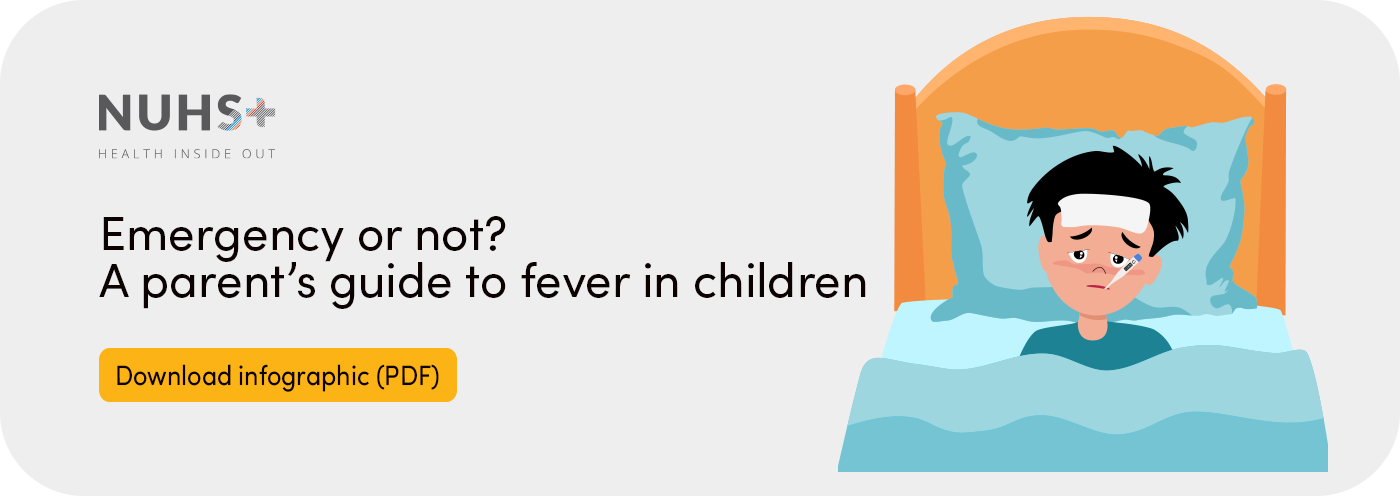Published on 8 January 2024
Learn the red flags to watch out for in paediatric fever and its underlying causes, so you can better care for your child.
Every parent knows the feeling – that moment of anxiety and uncertainty when your child comes down with a fever. As parents, your mind would be racing with questions and worries when it happens. Will their high body temperature cause brain damage? Are frequent bouts of fever a cause for alarm?
Dr Jasmine Ho, Consultant with the Children’s Emergency at Khoo Teck Puat – National University Children's Medical Institute (KTP-NUCMI) at National University Hospital (NUH), shared that a fever in itself is not harmful. “Fever is one of the body’s ways of manifesting an infection or inflammation, and often accompanies other symptoms of infection,” she explained.
Most fevers in children will range between 38 and 40 degree Celsius, and last for three to five days. They are typically the result of minor infections that resolve on their own. “The height of the fever does not necessarily reflect the severity of the illness. What matters more is the overall pattern of the fever and how the child behaves — his mood and energy levels, for example,” stressed Dr Ho. She added that parents should seek medical attention if the child displays any red flag signs such as breathlessness, dehydration and lethargy.
Causes of fever
|
Contrary to popular belief, fever itself doesn’t lead to brain damage, though there may be associations of high fever in young children with febrile fits. Dr Ho explained that febrile fits are brief seizures that some infants and young children might experience in response to a rapid spike in body temperature. Fortunately, these episodes typically resolve on their own and do not have any long-term effect on the child’s growth or development.
A healthy child can experience up to two episodes of fever per month, especially if they are exposed to common childhood illnesses. This may occur when they start attending infant care or childcare — or have elder school-going siblings.
“We see a pattern of a child suddenly falling sick more often once they start school, though this will gradually improve after their immune system gets used to the microflora in the school environment,” said Dr Ho.
When a fever is something more serious
While having fluctuating body temperature is common for children who are ill, a fever above 38 degree Celsius in infants less than three months old is often a red flag. In such instances, seek medical attention at the Children’s Emergency immediately, where appropriate investigations and pre-emptive treatment will be administered.
A doctor may also decide whether further investigation is needed if there is prolonged high fever of five days or more, especially if the child does not seem to be getting better. “In general, screening blood tests with a Full Blood Count can help to differentiate between bacterial and viral infections, but they do not identify the source. Further tests such as urine screens, chest X-rays, throat/respiratory swabs or other blood tests may then be required,” Dr Ho said.
In rare cases, fever may be a sign of something more serious, such as cancer, autoimmune diseases or immune system disorders. However, Dr Ho noted that such underlying conditions usually come with other symptoms.
“Often, there will be other accompanying signs such as a pale appearance, weight loss and persistently swollen lymph nodes among others, depending on the underlying condition in question,” she mentioned. “In cases of a chronic underlying condition, a child would exhibit poor overall growth. This, coupled with the pattern of infections and other associated symptoms, will enable doctors to investigate for specific underlying conditions if required,” Dr Ho added.
Read on to learn what to do when your child has a fever.
KTP-NUCMI is an arm of National University Centre for Women and Children (NUWoC).
In consultation with Dr Jasmine Ho, Consultant, Children’s Emergency, KTP-NUCMI.





